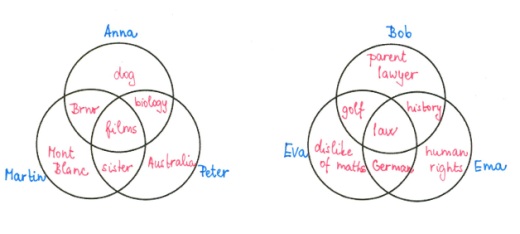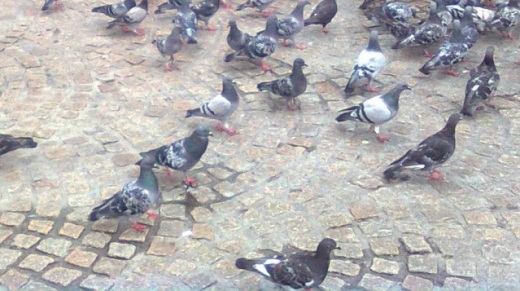Getting to Know Each Other: Icebreakers in ESP (or Elsewhere)
Štěpánka Bilová, Radmila Doupovcová, Barbora Chovancová and Hana Němcová, Czech Republic
Štěpánka Bilová, Radmila Doupovcová, Barbora Chovancová and Hana Němcová all work at Masaryk University Language Centre, Brno, Czech Republic. While the first three specialize in Legal English, Hana teaches students at the Faculty of Science. They share love for effective classroom activities and here they present how they revamped a few all-time favourites to work really well with present day students.
E-mails: bilova@law.muni.cz, radmila.doupovcova@law.muni.cz,
barbora.chovancova@law.muni.cz and nemcova@rect.muni.cz
Menu
Introduction
A. Icebreakers for new students
Icebreaker 1: What do we have in common?
Icebreaker 2: Wild guesses and a reality check
Icebreaker 3: Teacher presentation
B. Follow-up icebreakers
Icebreaker 4: What did you do over the Summer?
Icebreaker 5: Photo icebreaker
Conclusions
References
From our teaching experience, we all know that icebreakers represent an effective teaching method. It is, however, good to know that research supports our teacher intuition. A good example of such theoretical work is Chlup and Collins’s article on using icebreakers with adult learners where they not only present sample activities, but also justify using them by claiming that “they help group members get acquainted and begin conversations, relieve inhibitions or tension between people, allowing those involved to build trust with and feel more open to one another. Icebreakers encourage participation by all, helping a sense of connection and shared focus to develop” (Chlup and Collins 2010: 34), they also state that icebreakers “bring humor into the class, establish rapport, foster a safe learning environment” (ibid.). This is a belief we can subscribe to!
At Universities, language courses often last several terms. The icebreakers we present in this part are designed for first-term students, with the primary aim for the students to get to know each other and to create a positive atmosphere. Unlike the follow-up icebreakers described below, these do not require any previous content knowledge.
Level: A2 to C2
Skills: speaking (comparing and contrasting)
Time: 15–30 minutes
Preparation: Pieces of paper with blank intersecting circles (one for each group)
Faculty: Any
Students work in groups of three and they have to find out what qualities/interests etc. they share. They are asked to fill in intersecting circles (see Fig. 1) to help them organize and visualize their thoughts. Finally, they present their findings in front of the whole class.
The activity with intersecting circles (two or three) need not be limited to language classes or icebreakers, see e.g.
http://activeafterschool.ca/activities/icebreaker-venn-diagram

Figure 1: Intersecting circles indicating common and individual interests: Faculties of Natural Sciences and Law
Level: A2 to C2
Skills: speaking (comparing and contrasting)
Time: 30–45 minutes
Preparation: Printed copies of “Wild guesses and a reality check table” (one for each student)
Faculty: Any (but all students are from the same faculty)
Students work in groups of three. They are given a chart (See Fig. 2) and their task is to look at one of the group members and make guesses about different facts concerning them, ranging from the town they come from to reasons for enrolling at the particular Faculty. They need to write their guesses down.
After they have finished, they are allowed to speak and compare their guesses with what is truth about their new friends.
Finally, they are asked to share the most surprising/interesting/funny contrasts in class, introducing their new colleague to the whole class and to the teacher (indirect speech practice).
Examples of students’ summaries:
- This is Katka. I thought that Katka wanted to study law because her mother, her grandmother and her great-grandmother are all lawyers but in fact she decided to study law because she lives next door.
- The most surprising thing I learned was that both of my colleagues are looking forward to Roman law - I thought they would be more interested in business law.
- Meet my new friend, Tereza. I saw a picture of a dog on her laptop screensaver, so I expected her to be interested in zoology. But no, surprisingly, her field of study is anthropology.
Name:
| Your guess | Reality |
| Where from | | |
| Reasons for studying law/natural sciences/any other | | |
| Subjects they are looking forward to | | |
| Expectations about school (what the school will equip you with) | | |
| Attitude to English | | |
Figure 2: Wild guesses and a reality check table
Level: A2–C1
Skills: speaking (making guesses/giving opinion, making questions)
Time: 40–50 minutes
Preparation: printed copy of the options (one for each student), music recordings (e.g. from the Internet)
Faculty: any
This activity involves making guesses not about the classmate but about the teacher. The teacher prepares a quiz based on her/his preferences. Five areas are sufficient (printed on a strip of paper). Students are encouraged to guess what the teacher likes doing. More options from each section are possible. First, students work individually, then discuss the possible teacher´s preferences in groups (of four or five) and prepare yes-no questions to find out the reality. Grammatically correct questions and varied introductory phrases are expected. (Teacher can elicit the phrases and write them on the board – e.g. do you like, do you prefer, are you into ...).
Example:
Sports: squash, yoga, cycling, aerobics, swimming, volley ball, basket ball
Hobbies: stamp collecting, gardening, silk painting, woodcarving, embroidery, housework
Areas of interest: politics, economy, ecology, law, education, IT
Travel “wish list”: South Pole, India, Las Vegas, New Orleans, Canary Islands, Peru
Music: 1 2 3 4 5 (Teacher plays short samples of different genres of music)
As a follow-up activity, students can do the same about themselves. Using the same headings, they prepare options and let their new friends guess what is correct.
Unlike the icebreakers in the previous section, follow-ups are designed not only to start the term in a positive and active way but also to revise and activate something learnt in the previous term.
Level: A2 to C2
Skills: speaking
Time: 15–30 minutes
Faculty: law (can be adapted to fit other contexts)
This is a question all of us heard when learning English all those years ago. This particular version of it was designed to quickly ease into a lesson in which other work needs to be resumed soon.
Students are given the following three questions; they should provide specific details in their answers:
- Did you use general English over the Summer?
- Did you use law over the Summer?
- Did you use Legal English over the Summer?
A tip for making the beginning of discussion easier: the teacher offers examples of using English (watching films in English, helping foreigners who were lost in the city), describing legal situation (being fined for speeding, signing an employment contract) and using legal English (being fined for speeding in England, reading the terms and conditions when purchasing a cell phone on eBay).
Level: B2 to C2
Skills: speaking
Time: 30–45 minutes
Preparation: an e-mail with instructions to students, sent beforehand
Faculty: law (can be adapted to fit other contexts)
Students love using modern technologies and this activity was designed to use this fact to our advantage. About a week before the term starts, students receive an e-mail, asking them to take a photo from their everyday life and bring it to the first class. The students are aware of the fact that these pictures are to be interpreted according to their area of studies. They are given a choice of bringing the pictures in a printed or digital form.
To give an example, students of Legal English classes are asked for legal analysis of their photos. In class, they work in groups of three or four. First, one by one, they show their photos to their groupmates who are asked to come up with possible legal interpretations. Finally, the owner of the photo presents the legal description he or she had in mind originally.
An example:
A student brought a picture of pigeons in the street (see Fig. 3) and this was a starting point for discussion on public nuisance, the legal aspects of pest control and the advisability of imposing speed limits. The student’s original idea was to use this picture as an illustration of the change of the status of live animals in the New Civil Code.
The same picture could be used with students of biology. It can raise the question of the harmful effects of city pigeons on human health.

Figure 3: A photo for the photo icebreaker activity
All the above described icebreaker activities have been tried and tested and can be easily adapted for other teaching contexts than Natural Sciences or Law. Apart from the undeniable benefit of getting to know one another, students get a chance to plunge into English after a break and activate their knowledge in a stress-free environment. We hope that readers will find some of our ideas interesting and use them in their own classroom. If you do, we would be most interested to hear from you!
Chlup, Dominique T.; Collins, Tracy E. (2010). Breaking the Ice: Using Icebreakers and Re-Energizers with Adult Learners. Adult Learning, June 2010, 21: 34-39
Retrieved from http://alx.sagepub.com/content/21/3-4/34.refs

Please check the Teaching with Minimum Materials course at Pilgrims website.
Please check the Creative Methodology for the Classroom course at Pilgrims website.
Please check the Methodology & Language for Secondary Teachers course at Pilgrims website.
Please check the Methodology & Language for Secondary Teachers course at Pilgrims website.


|